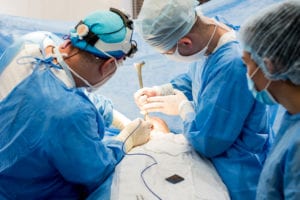Sometimes what goes in, must come out. In the case of breast augmentation, breast implant removal, also known as explant surgery, is a surgical procedure that removes (or explants) the implants from the breast pocket. Explant surgery is done for a number of reasons, from breast implant illness to end of their natural lifespan (it’s recommended that you replace your breast implants every 10 years to avoid any complications) to capsular contracture or rupture and even simple just change in your preferences.
What is capsular contracture in breast implants?
 Breast implant capsular contracture is a complication that occurs when the scar tissue that usually forms around your implant to help keep it in place, instead tightens and squeezes the implant, potentially resulting in chronic pain and a distorted breast shape, making the affected breast rise higher on the chest than the other. Occurring nationwide in about one in twenty four patients, capsular contracture can occur at any time after your augmentation, though approximately three-fourths of all incidences of capsular contracture will occur within two years. Capsular contracture symptoms and signs to watch out for are increasing firmness or tightness in the breast, pain, and/or the breast makes a shift towards the center of the body. You may notice the implant starting to move up but the breast stays lower, so if you see a mound or a firmness that’s increasing up on the top of your chest, you should speak with your surgeon to assess further.
Breast implant capsular contracture is a complication that occurs when the scar tissue that usually forms around your implant to help keep it in place, instead tightens and squeezes the implant, potentially resulting in chronic pain and a distorted breast shape, making the affected breast rise higher on the chest than the other. Occurring nationwide in about one in twenty four patients, capsular contracture can occur at any time after your augmentation, though approximately three-fourths of all incidences of capsular contracture will occur within two years. Capsular contracture symptoms and signs to watch out for are increasing firmness or tightness in the breast, pain, and/or the breast makes a shift towards the center of the body. You may notice the implant starting to move up but the breast stays lower, so if you see a mound or a firmness that’s increasing up on the top of your chest, you should speak with your surgeon to assess further.
What happens to the capsule after implant removal?
Not all explant surgeries are created equal, so not all capsules are removed during explant surgeries. After a traditional breast augmentation with implants, scar tissue, or a capsule, naturally forms around the implant. A capsulectomy is the removal of that capsule, and there are different levels of removal procedures, which are dependent on the complication or reason of removal:
- A subtotal or partial capsulectomy removes only a part of the scar tissue capsule and likely replaces your implant. Additionally, your surgeon
 may only need a smaller incision for this type of capsulectomy
may only need a smaller incision for this type of capsulectomy - A total capsulectomy removes all of the scar tissue capsule, including the scar tissue lining around the implant, and very likely the implant as well, and involves removing the implant first, followed by the capsule
- An en-bloc capsulectomy removes the entire capsule, including the enclosed implant, at the same time and in one-piece
No matter your reason for removal, it may feel disheartening to think that you’ve come so far in your augmentation journey, only to face being back at square one, you don’t have to let it prevent you from having the body you want and finally feeling comfortable in your own skin. Being proactive about choosing your surgeon, your postoperative care, and any possible changes in your implants can prevent or mitigate non-elective reasons for removal.
Do you want to learn more about Barrett Plastic Surgery? Keep up to date by subscribing to our blog and following us on social media at Twitter, TikTok, Instagram, Realself, YouTube, Snapchat, Yelp, and Facebook for updates.
Thank you for visiting!


